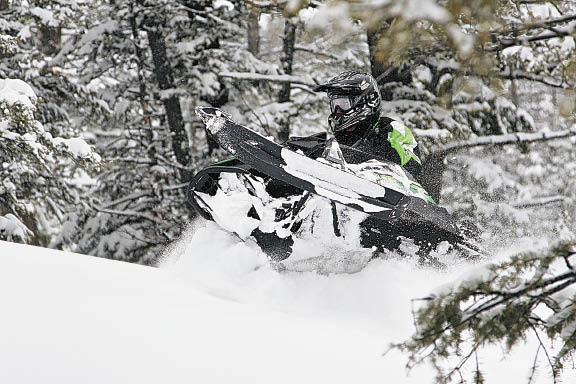 "When in doubt throttle out" is actually an unsafe practice to rely on and usually is the result of a rider reacting late or behind a compromising situation. A rider who has mastered the skill of throttle control does not refer to this phrase often or at all.
"When in doubt throttle out" is actually an unsafe practice to rely on and usually is the result of a rider reacting late or behind a compromising situation. A rider who has mastered the skill of throttle control does not refer to this phrase often or at all.
Disciplining yourself to slow down to maintain control by applying only as much throttle as needed to execute a maneuver or traverse terrain fluidly is the result of understanding precision throttle control. Riders with this correct aptitude of skill avoid unwanted or unsafe situations and are always in control of their speed while maintaining situational awareness around them.
Throttle control, in reference to three "Points of Common Correlation," acts as the "governor" or "that which controls speed and efficiency of energy in motion." It is never completely mastered to one specific act or application for the obvious reason that no two lines of travel, terrain or conditions are identical.
Now, if we set these factors aside, there is one more complex mental and physical combined factor entwined in every scenario. Its complexity affects a rider's throttle control competence either in a positive or negative dynamic. It is known as "neuromuscular junction and chemical exchanges" or in layman's terms, our "mind-body connection." In order to refine this rider motion through the 34 muscles and 48 nerves that control the fingers and thumb, we need to step back further into a rider's predisposed mental and physical state as it is key for finesse of this function. This is why throttle control is probably the most complex factor when learning to ride any motorized vehicle and ultimately what defines a rider's level of confidence and control when faced with challenging terrain.
In a previous issue [SnoWest, September, 2011, page 45] I addressed the importance of rider input, geometry and body language and in point, a critical tip of importance, "Where you look is where you go." When we are "looking ahead" while applying the throttle it would be convenient if it were as straightforward as transferring the information from an imaginary "throttle input chart" embedded in our brain.
Instead our nervous system is relaying a multitude of information derived from past to current emotions of the known and unknown to result in the delivery of physical action (our neuromuscular junction). The physical aspect (chemical exchange) is what can be an added curveball, depending on the level of rider fatigue as a direct result of rest, hydration and nutrition. These are the dynamics of the "mind-body connection" and how it processes our speed, memory, attention, problem-solving and flexibility to a situation. When mixed together, it dictates the fluidness of motion as to how much and when to squeeze that throttle.
Now let's think about how looking ahead affects throttle input on the "mind-body connection" principle. Imagine an individual taking a long road trip. First let's compare the driver's performance and mind clarity at 2 p.m. in the afternoon on the Interstate in comparison to that same driver traveling later at 2 a.m. in the duration of this same trip. The driver, fresh and unfatigued, maintains a consistent speed of 65-75 mph during the early afternoon and maintains a distant line of vision ahead. Later, that same driver at 2 a.m. has lost focus from fatigue and is unable to maintain a distant line of vision and his focus is just over the hood of the car. The result is speed fluctuation and hesitation from irregular throttle input and lack of confidence from fatigue.
If we transfer this scenario to a snowmobile, a rider's throttle input as a result of physical and mental fatigue is the same. A rider tends to hesitate or back out of the throttle as he brings his line of vision in close and over the hood. Riders will then become stuck more frequently and in some cases compromise the necessary track speed and flotation to maintain a technical line of travel that can result in a damaged sled or injury.
I see this as a common mistake among novice to intermediate riders as they are often not looking out ahead and instead prone to looking down at the skis or directly over the hood of the machine. When the result is repeatedly getting stuck, novice riders tend to tire and get frustrated quickly without proper training.
Though throttle control is complex in its delivery, the exercises like those I incorporate into Backcountry Basics clinics are elementary. Contrary to disbelief from our delicate egos, any rider will advance from his or her current skill level when practicing on flat terrain in an exercise I call "100 yards of slow speed stops and gos." On flat terrain a rider focuses on a destination to traverse toward at no more than a "walking speed' while on pivot. The goal of the exercise is to smoothly and consistently "roll on and roll off" the throttle and maintain the sled on pivot throughout.
This builds confidence by familiarizing the rider through repetitive motor skill training that will overwrite any predisposed bad habits applying to throttle input and then they have strengthened their "mind-body connections" that will become evident later when faced with difficult terrain.
Connecting the three back together, a machine's performance directly mirrors throttle input and consequent throttle input mirrors the rider's input.
So remember, "When in doubt, take some time out" and practice.
Holt owns and operates Backcountry Basics and teaches riders of all skill levels how to improve their snowmobiling skills at locations across the snowbelt. For more information, visit backcountrybasics.com.